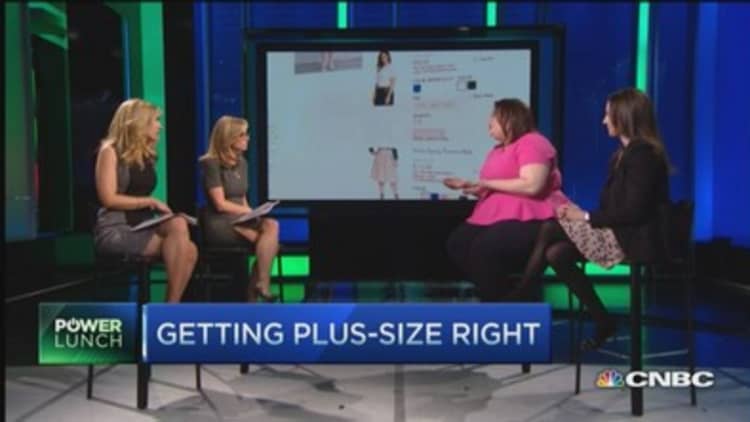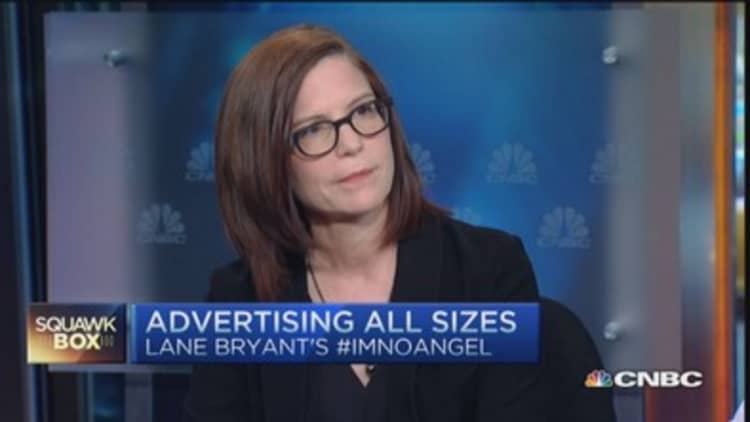
It's a big market opportunity with growing sales potential, but retailers can't seem to figure it out.
The plus-size apparel market generated $17.5 billion in sales between May 2013 and April 2014, up 5 percent from the year prior, according to market research firm The NPD Group. But that figure likely under-represents the true opportunity of the demographic given that the average American woman is a size 14, according to the Centers for Disease Control and Prevention.
Mariah Chase, CEO of plus-size retailer Eloquii, said she estimates that 65 percent of American woman are considered plus size, but the category represents only about 17 percent to 18 percent of apparel sales.
Despite the huge potential for growth, retailers have had difficulty competing in the category, a point that has often led to frustrated consumers. But there are signs of a shift as new retailers take up the challenge.
"For so long, we have been purchasing from a place of utility," said Sarah Conley, a plus-size fashion blogger and social media marketing consultant. "While it's getting better, [the plus-size community] still doesn't feel like we have the fashion options that we want in terms of fit and style."
According to Chase, "it's a vicious cycle for retailers, which makes them scared to step into the water."
Read MoreLululemon strikes a new pose: Full-figured tanks
Plus-size clothing hasn't always been fashionable, trendy or well-made, and often it has been located in "dismal areas" of the retail store, Chase said. Both factors made shopping for plus-size clothing less than a pleasant experience. She said that when the items didn't sell, retailers often blamed demand rather than their ability to meet it.
"If you are a store that has a plus-size section, that says to me that I am welcome there. But, the more I go in and am disappointed by the plus-size section, which continues to shrink and get pushed out by expanding maternity or accessory sections, the less I want to go in," said Conley. "If I had an event tomorrow, I'm kind of screwed. There aren't that many in-store options for me in New York."
According to market research by online retailer ModCloth, 77 percent of plus-size women say it is difficult to find well-fitting garments; 73 percent say sizing is inconsistent across brands; and 81 percent say they would spend more on clothing if they had more options in their size.
"Retailers [are] not seeing the returns they want they want to see, and consumers aren't seeing what they want to buy," said Conley.
Despite this conundrum, there are retailers that keep trying to get it right for the plus-size shopper. Fast fashion retailer H&M has H&M Plus, J.C. Penney has its plus-size a.n.a brand.
Read MoreNo longer ignored, retailers cater to curvy women
Target garnered a lot of fashion media attention when it launched its first plus-size only brand, AVA & VIV, in February. Spokesman Joshua Thomas said the line has "exceeded expectations across the board."
Although Thomas declined to provide specific sales figures, he said some items in the line were so popular that Target has put them back into production to satisfy consumer demand, and plans to boost quantities of some items for future installments of the line.
Getting it right
There's much more to creating these designs and getting it right than simply scaling up. It does require special design expertise and production, which often results in a higher price for the consumer.
"There is more production expertise and fit expertise that is required and they don't teach it in school. The whole industry learns one shape, and fits on one, much smaller, straighter shape," Chase said.
Gap's Old Navy felt the backlash in November when an online petition circulated requesting the retailer charge the same prices for all its women's sizes. One thing that was flagged for was that Old Navy's pricing for larger men's sizes didn't vary as much as it did for women, and the retailer explained it's because the fit for men isn't as particular as it is for women.
"For women, styles are not just larger sizes of other women's items, they are created by a team of designers who are experts in creating the most flattering and on-trend plus styles, which includes curve-enhancing and curve-flattering elements such as four-way stretch materials and contoured waistbands, which most men's garments do not include ... this higher price point reflects the selection of unique fabrics and design elements," the company said in a statement explaining the difference.
More price sensitive?
Even with some of the extra production costs passed on to the consumer, plus-size apparel still often has lower margins, or is less profitable, than non-plus size clothing. A concurrent issue is that the higher price point seems to be a particular pain point for the demographic.
Conley acknowledged the plus-size consumer can be more price sensitive than other shoppers. In social conversations, she said she often sees mentions of shoppers who buy only during sales and look for deals.
Conley said her theory is that plus-size shoppers aren't as used to having the opportunity to treat themselves to special apparel such as their smaller-size counterparts, because there haven't been equivalent options.
Read MoreWhy luxury brands have finally given into digital
Chase agreed with Conley, but thinks a lot of it has to do with how this customer has been handled by retailers and media.
"She's been told by retailers, and fashion media in particular, that she shouldn't be the size she is. In her mind she thinks she will change in the future to be what she should be. So for this customer in particular, the 'ideal' is very magnified, and that mitigates her elasticity on spending," Chase said.

Unfortunately, even with special production, plus-size clothing may still feel ill-fitting to a large portion of plus-size consumers, which leads to lower sales.
"When I think about my readers, and the general conversation [in the category], we are all differently shaped," said Conley. "I'm 6'2" and not curvy, while others are much more pear-shaped. It does feel like an improbability that one fit works for all of us."
Chase concurs. "The reality is, there is more of a fit challenge once you get above a size 14. There is more body variation in larger sizes than in smaller sizes," she said.
Plus-sized power play
However, it's certainly not an impossible retail niche to figure out, and more fashion outlets, retailers and specialty brands are working to serve the plus-size community, especially a few online players such as Eloquii, ModCloth and subscription-based Gwynnie Bee, which are getting buzz in the plus-size community.
The Eloquii brand, which Conley has worked with as a consultant, was originally run by The Limited (now L Brands), but was shut down in spring 2013. However, after consumer outcry began to gain momentum, its founding team was motivated to restart the brand, and relaunched it online in the early fall of 2013. Among its fans are actresses Melissa McCarthy and Rebel Wilson.
Read MoreReinventing fashion with a Silicon Valley twist
While Eloquii's merchandise is mainly available through its website, some designs are also now available on Nordstrom's website. Chase said sales grew 100 percent from the third to the fourth quarter and that metrics continue to beat the company's own internal projections.
Online retailer ModCloth said its plus business doubled from June 2013 to June 2014, making it the fastest-growing business segment. The success has increased the number of plus-size designers from 35 to more than 160, a number that keeps growing.
Specialty retailers Lane Bryant and Catherines, both owned by Ascena Retail Group, are among the market leaders.
This week, Lane Bryant began its "I'm No Angel" marketing campaign, featuring some of the best-known plus-size models wearing the retailer's exclusive Cacique lingerie collection. It's a playful poke at the iconic "angel" marketing from rival Victoria's Secret, which features models with more Barbie-esque proportions.
Lane Bryant CEO Linda Heasley told CNBC, "It wasn't our intention to clip the wings of any brand and we're not trying to throw shade."
Instead, her brand is embracing who the American woman is, aiming to lead with fashion rather than size, she said.
"Arguably, the definition of beauty as defined by an angel, which reflects perfection, is unattainable for most of us. And so what we're saying is it's about more than that. It's about being who you are and embracing that," Heasley said.
New opportunities
While plus-size models have been featured in fashion for years, it seems like more mainstream fashion outlets and businesses are warming up to incorporating them more. Ashley Graham, a plus-size model featured in the Lane Bryant campaign, was in Sports Illustrated's most recent swimsuit edition, and told CNBC, "I plan on being on the cover of Sports Illustrated next year. Watch out."
Graham isn't the only one optimistic about the future for plus-size fashion. Conley said brands are getting better at offering merchandise for what she calls an underserved population and adds that the visibility is improving thanks to campaigns like "I'm no Angel" and trending social conversations, pointing to hashtags like #PlusSizePlease.
"These women are the important voices; retailers should listen," Conley said.
"The opportunity is right here in front of us. We want more players in the market because it will help adjust her mindset and encourage her to play in fashion," Chase said. "If we have the potential to democratize size, it's a fantastic opportunity for retail."


